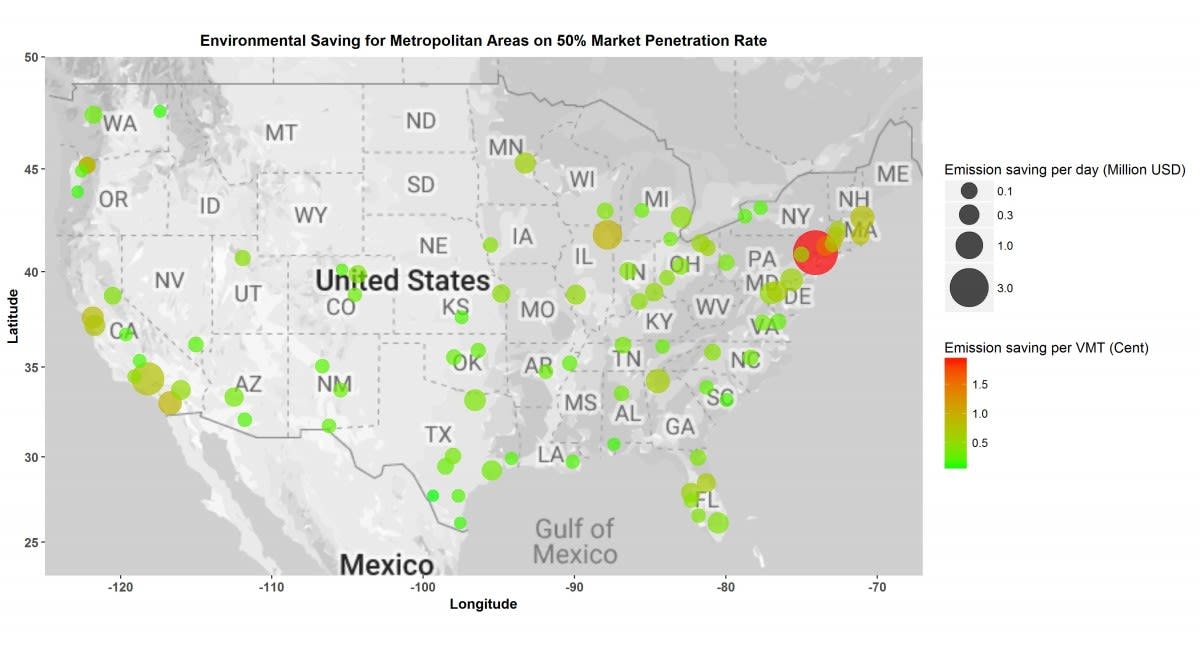Stevens professor Yeganeh Hayeri explores the ways vehicle technologies can save lives, trim climate-warming emissions, and conserve fuel
Driverless cars are increasingly in the news, even if they aren't yet ready for prime time.
Yet many of the advanced technologies that help those vehicles steer, stay in their lanes, avoid collisions, navigate through or around traffic and park safely are already being built into cars now.
And that leading-edge tech, says Stevens School of Systems and Enterprises professor Yeganeh Hayeri, can help save lives, keep the air cleaner, save consumers money at the pump and preserve crops and forests.
"Advanced automated technologies in vehicles on the road — not making them driverless, simply upgrading the available technological systems — can benefit us in many ways that we are now beginning to understand," says Hayeri. In a collaboration with Carnegie Mellon University, her team recently put a number on the potential fuel-cost savings alone, and it's eye-opening: as much as $6.2 billion annually.
That's just one of several projects Hayeri — who specializes in the study and modeling of transportation systems, technologies and behaviors from a big-picture perspective — is working on to help us better understand future transportation... and the ways technology could help improve it.
How to save $6 billion
Commuting, or even just doing errands around town, can be a frustrating experience in densely populated communities.
Traffic congestion, construction, the parking game, fellow drivers rubbernecking at accidents: all of these factors can slow down the ride. Meanwhile, all that extra idling at stoplights, intersections and construction zones — and circumventing traffic, getting lost and found, and driving too fast or too slowly — burn extra fuel, cause unnecessary accidents, and burn a hole in our wallets.
Multiply your own commute by 260 million, the estimated number of cars on the road in the U.S. today, and it adds up a huge economic and environmental challenge to solve.
Yet it turns out there's already a partial cure available, says Hayeri.
For her fuel-efficiency study, conducted with Stevens Ph.D. student Saeed Vasebi and researchers at Carnegie Mellon, Hayeri considered various low-level automated systems available for passenger cars and other light-duty vehicles.
These include a host of technologies and services such as blind-spot cameras; lane-keeping warnings; various forms of cruise control that help maintain constant speeds, which are gentler on fuel use; and real-time mapping and route-optimization, which guide drivers to the quickest, least congested routes.
"Those systems are demonstrated to reduce the likelihood of accidents and idling in traffic, as well as improve a vehicle's aerodynamic efficiency," explains Hayeri. "All these factors improve fuel efficiency and lower total fuel costs — both for vehicles with 'smart' systems and, more subtly, for all the other vehicles on the road, as well."
To figure out the total impact, the Stevens-Carnegie Mellon team created a series of sophisticated stochastic equations and models to predict how 'smarter' driving would affect fuel consumption nationwide.
"In the end, we found that the fuel consumption of light-duty U.S. vehicles — cars, pickup trucks and sport-utility vehicles — would improve by between 6 and 23 percent," says Hayeri. (The range factors in various scenarios of technology adoption and the effectiveness of the technologies involved.)
That translates to between $60 and $266 in the pocket of car owners every year, plus about $35 in additional annual savings created for each driver (automated or not) thanks to more smoothly-flowing traffic: a total possible benefit of $300 a year, and $6 billion in all, if the market share of those advanced technologies rises to around 90 percent.
"This is even after factoring in the additional power and fuel consumed by automated systems such as radars, sensors and cameras in a vehicle," she notes.
Vehicle tech improves air quality, human health, the environment
Hayeri also studies the broader societal effects of deploying smarter automated systems in vehicles.
Her team recently concluded that the health and environmental benefits of adopting low-level automated technologies are enormous — on the order of several times larger than the billions potentially realized through fuel-cost savings alone.
For that analysis, Hayeri expanded her model, using an 86-urban area dataset and factoring in the various air pollutants emitted from vehicles. Those substances include carbon monoxide (dangerous to humans) and dioxide (a "greenhouse gas" that warms the atmosphere); sulfur dioxide (which contributes to damaging acid rains); and ammonia, nitrous oxide, particulate matter and other volatile compounds that can kill or sicken us from asthma, cancer, heart attack, stroke and other diseases.
The final verdict: up to $25 billion worth of benefits could potentially accrue, nationwide, if automated technologies are more fully deployed in our vehicles. And residents in the congested New York City, Chicago and Atlanta metro regions would benefit the most.
"We're talking about a host of benefits, from cleaner air and fewer deaths to more forests and green space remaining healthy and green to less agricultural loss due to those pollutants," Hayeri explains.
Interestingly, the most effective vehicle tech depends upon where you live, since local air quality, land use, vehicle usage, traffic patterns and other factors all vary considerably from city to city.
In the New York City metro area, for example, the ever-present congestion (including a high density of taxis, buses, pedestrians and cyclists) is the main drain on fuel efficiency and a leading cause of accidents. So-called cooperative and adaptive cruise control technologies, which help make decisions about when to accelerate or brake (or not), can alleviate a significant portion of that waste, Hayeri's group learned.
In Los Angeles, things are different: drivers waste fuel and time circling city blocks in a desperate hunt for parking. So that's where better mapping, route guidance around traffic and systems to assist with the actual parking can help save lives, crops and gas, discovered the Stevens team.
"In terms of policy," Hayeri says, "these results suggest that a targeted adoption and promotion of automated technologies can maximize the collective energy and environmental cost savings for us all."
When moods, weather, and driverless cars converge
In still another effort, Hayeri investigates the human factor: our driving behavior.
Existing traffic-planning models, she points out, have long used simplistic, two-car equations to describe the ways we drive. But the reality is a lot more complex than that. Tapping a huge database and using a powerful new model, her team is now analyzing so-called car-following behavior from a number of fresh perspectives.
"It matters how much traffic, and what kind, is around you," she says. "It matters what the terrain is, and what the weather is. Whether or not you had coffee. And other characteristics may matter. We will look at gender, race and a range of other variables to see if any appear to significantly impact driving behavior."
Driving behavior matters because, one day, conventional and self-driven vehicles will begin sharing the road — and we don't have any idea how well they will get along.
"Lots of people talk about this glorious future when there are only driverless vehicles on our roads, but it's going to take us 40 to 50 years, at least, to get there. Between now and then, the reality is going to be messier. It's going to be a mix."
That means our theories, models and planning will be forced to change, perhaps rapidly and substantially.
"Believe it or not," Hayeri concludes, "traffic-planning models used by decision-makers have not changed much since the 1950s. They need to reflect what's actually happening and is going to be happening out there on the road, rather than relying a 40-year-old theory.
"Broadly speaking, that's why I do this: to help anticipate and plan for the future."




